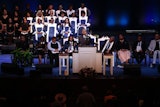Not since the Oakland, Calif. School Board voted in 1996 to recognize Ebonics as a language to be factored into its speakers’ English classes — sparking a national debate — has there been so much focus on African-American speech patterns. Fast forward to 2007, and we now have the appalling case of the Houston Independent School District (HISD) police officer who, for whatever reason, saw fit to produce and distribute the Ghetto Handbook: Ebonics 101 to fellow school district officers. From the debasing cover illustration of two Black men, one brandishing a gun, to the offensive subtitle “Wacha dun did now?” — including the outrageous poem thrown into the mix — this document is rife with racist and offensive African-American stereotypes.
The good news here is that this is a rare and profound teaching moment, and it should be treated as such. It is clear that ignorance abounds in this country with regard to African-American language, and this unfortunate incident speaks to the need for greater education and understanding in this area. To begin with, it must be made clear that Ebonics and slang are not one and the same. Words like “hoodrat,” “gank,” “bling,” and much of the list in the “Handbook” are not Ebonics, but slang words promulgated in urban America and in some hip hop songs and music videos.
American Ebonics is a contact language that resulted from the mingling of non-English-speaking, displaced and enslaved Africans with English speakers. Hence, its lexicon is English, but many of its grammatical structures and its syntax, according to some linguists, closely resemble those found in West African languages. This is not unlike the practice of African-descended persons melding traditional African religions, whose practice were forbidden, with Catholicism, creating the widely practiced Santeria.
At any rate, Ebonics is the primary language spoken by many African-Americans, particularly those lacking formal schooling. Still, there are even countless middle class African-Americans (this writer included) who are fully capable of speaking formal English — and who do so on a regular basis except on those occasions, in relaxed, informal settings among family and/or friends, when Ebonics is sometimes spoken. This phenomenon, which is almost second-nature, is called code-switching, and it is very common among people who speak more than one language. It is also worth noting that Ebonics is a graduate level course offered, and completed by this writer, in the doctoral African-American Studies program at Temple University. Of course, there is an ongoing debate about whether Ebonics is an actual language, or just a dialect; however, that is a matter that will not be resolved here, and is best left to the socio-linguistic community.
What is not disputed, though, is the fact that the vast majority of African-Americans, to varying degrees, speak in a tongue that is all their own — and they should not be demonized or ridiculed because of this. After all, lest we forget, African-Americans are the only immigrants in this country who were forcibly stripped of their mother tongue. Thus, many view this retention of African language as an amazing testament to the resilience of the African-American spirit, and as a form of resistance to outright deculturation.
Moreover, it is important to realize that language is an integral part of the cultural mosaic and, as such, must always be factored into the study of the African-American experience — and in diversity training, at HISD and in the teaching of African-American children. This is what the Oakland School Board had in mind before the media took hold of the story and advanced the ludicrous and spurious idea that they were planning to teach Ebonics to the students, when they really intended to use Ebonics as a bridge in teaching and learning formal English, much like in bilingual education programs.
When all is said and done, HISD School Board member Larry Marshall was right in pointing out that “these are very racially sensitive times.” This is the period of the Jena Six, when excessive criminal charges against six young African-American young men for a school fight that was sparked because Black students dared sit under the “White tree” in Jena, La. prompted thousands to converge on the small in an historic march reminiscent of those of the Civil Rights Movement. This is a period when the Hurricane Katrina aftermath is still fresh in the minds of many. In these times, the HISD must move swiftly to diffuse this potentially long-term problem.
Finally, diversity training is a wonderful tool, but it must not be trivialized. The bottom line is that such racism and poor judgment cannot be tolerated in America or on the HISD Police force, whose officers are sworn to protect and serve the students — most of whom are brown and black — in addition to the faculty and staff of the school district. This is a test that HISD simply cannot afford to fail. And the nation is watching.
Dr. Pamela D. Reed is a diversity consultant and assistant professor of English and African-American literature at Virginia State University.
There are currently 13 comments on this story.
Click here to post a comment
© Copyright 2005 by DiverseEducation.com


















